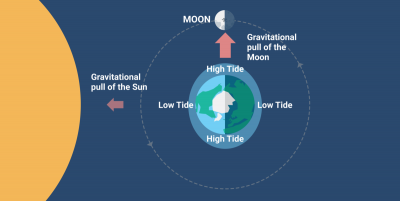
All objects on Earth feel the gravitational pull of the Moon in addition to that of the Earth itself and of the Sun. But the Moon’s and the Sun’s gravitational forces are negligible compared to that of our planet, which is ten million times stronger. These forces increase with mass so they become important when considering all the water in the oceans. This makes tides possible: water closer to the Moon is attracted to it inducing high tides, while other regions on Earth experience low tides. When the Earth rotates, high tide regions rotate too, hence the periodicity of tides. But it’s not just about oceans: the Earth’s solid surface also experiences tides and can rise up to a few tens of centimetres! Even if you don’t feel them, these tides can have dramatic effects such as earthquakes and volcanic eruptions.
Tides are one of the most reliable phenomena in the world, and we know that they move in and out around twice a day, but not exactly. So, why is that?
A day on Earth is the time it takes our planet to spin once around its own axis in relation to the Sun. This is known as a solar day, and it lasts around 24 hours.
However, the time it takes Earth to reach the same position in relation to the Moon is, on average, 24 hours and 50 minutes, known as a lunar day. The reason the lunar day is longer than a solar day is that the Moon revolves around Earth in the same direction as Earth rotates around its axis, so it takes Earth, on average, an additional 50 minutes to “catch up” to the Moon.
Because the tidal force of the Moon is more than twice as strong as the Sun’s, the tides follow the lunar day, not the solar day. It takes half a lunar day, on average 12 hours and 25 minutes, from one high tide to the next, so we have high and low tides nearly twice a day.
According to the National Ocean Service, there are some exceptions to the main rule of two tides every lunar day. Along the coastline of the Gulf of Mexico, there is only one tide per day due to the local shoreline topography, among other things. This tidal cycle is called a diurnal cycle, as opposed to the normal semidiurnal cycle, where diurnal means daily and semi means half.
Credit : Time and Date
Picture Credit : Google




